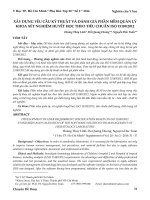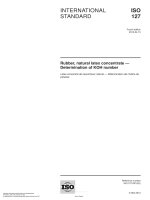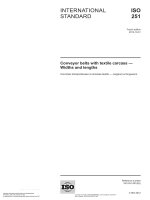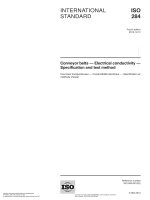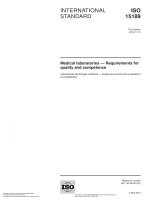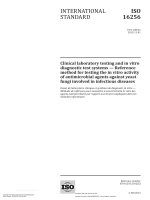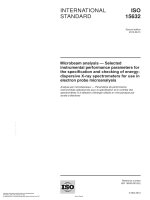Tiêu chuẩn iso 15685 2012
Bạn đang xem bản rút gọn của tài liệu. Xem và tải ngay bản đầy đủ của tài liệu tại đây (213.86 KB, 16 trang )
INTERNATIONAL
STANDARD
ISO
15685
Second edition
2012-07-15
Soil quality — Determination of potential
nitrification and inhibition of nitrification —
Rapid test by ammonium oxidation
Qualité du sol — Détermination de la nitrification potentielle et inhibition
de la nitrification — Essai rapide par oxydation de l’ammonium
Reference number
ISO 15685:2012(E)
--`,,```,,,,````-`-`,,`,,`,`,,`---
Copyright International Organization for Standardization
Provided by IHS under license with ISO
No reproduction or networking permitted without license from IHS
© ISO 2012
Not for Resale
ISO 15685:2012(E)
COPYRIGHT PROTECTED DOCUMENT
©
ISO 2012
All rights reserved. Unless otherwise specified, no part of this publication may be reproduced or utilized in any form or by any means,
electronic or mechanical, including photocopying and microfilm, without permission in writing from either ISO at the address below or ISO’s
member body in the country of the requester.
ISO copyright office
Case postale 56 • CH-1211 Geneva 20
Tel. + 41 22 749 01 11
Fax + 41 22 749 09 47
Web www.iso.org
Published in Switzerland
--`,,```,,,,````-`-`,,`,,`,`,,`---
ii
Copyright International Organization for Standardization
Provided by IHS under license with ISO
No reproduction or networking permitted without license from IHS
© ISO 2012 – All rights reserved
Not for Resale
ISO 15685:2012(E)
Contents
Page
Foreword ............................................................................................................................................................................ iv
1
Scope ...................................................................................................................................................................... 1
2
Normative references ......................................................................................................................................... 1
3
Terms and definitions ......................................................................................................................................... 1
4
Principle ................................................................................................................................................................. 2
5
Reagents ................................................................................................................................................................ 2
6
Apparatus .............................................................................................................................................................. 3
7
Sampling, storage and characterization of samples ................................................................................. 3
8
8.1
8.2
8.3
8.4
Procedure .............................................................................................................................................................. 4
Testing soils .......................................................................................................................................................... 4
Testing the effect of chemicals ........................................................................................................................ 4
Testing polluted soils ......................................................................................................................................... 4
Testing water extracts of biosolids ................................................................................................................ 5
9
Calculations .......................................................................................................................................................... 5
10
Test report ............................................................................................................................................................. 5
Annex A (informative) Results of a laboratory ring test ........................................................................................... 7
Annex B (informative) Micro-scale measurement of potential nitrification rates.............................................. 9
--`,,```,,,,````-`-`,,`,,`,`,,`---
Bibliography ..................................................................................................................................................................... 11
iii
© ISO 2012 – All rights reserved
Copyright International Organization for Standardization
Provided by IHS under license with ISO
No reproduction or networking permitted without license from IHS
Not for Resale
ISO 15685:2012(E)
Foreword
ISO (the International Organization for Standardization) is a worldwide federation of national standards bodies
(ISO member bodies). The work of preparing International Standards is normally carried out through ISO
technical committees. Each member body interested in a subject for which a technical committee has been
established has the right to be represented on that committee. International organizations, governmental and
non-governmental, in liaison with ISO, also take part in the work. ISO collaborates closely with the International
Electrotechnical Commission (IEC) on all matters of electrotechnical standardization.
International Standards are drafted in accordance with the rules given in the ISO/IEC Directives, Part 2.
The main task of technical committees is to prepare International Standards. Draft International Standards
adopted by the technical committees are circulated to the member bodies for voting. Publication as an
International Standard requires approval by at least 75 % of the member bodies casting a vote.
Attention is drawn to the possibility that some of the elements of this document may be the subject of patent
rights. ISO shall not be held responsible for identifying any or all such patent rights.
ISO 15685 was prepared by Technical Committee ISO/TC 190, Soil quality, Subcommittee SC 4, Biological methods.
This second edition cancels and replaces the first edition (ISO 15685:2004), which has been technically revised.
--`,,```,,,,````-`-`,,`,,`,`,,`---
iv
Copyright International Organization for Standardization
Provided by IHS under license with ISO
No reproduction or networking permitted without license from IHS
© ISO 2012 – All rights reserved
Not for Resale
INTERNATIONAL STANDARD
ISO 15685:2012(E)
Soil quality — Determination of potential nitrification and
inhibition of nitrification — Rapid test by ammonium oxidation
1 Scope
This International Standard specifies a rapid method for the determination of the potential rate of ammonium
oxidation and inhibition of nitrification in soils. This method is suitable for all soils containing a population of
nitrifying microorganisms. It can be used as a rapid screening test for monitoring soil quality and quality of
wastes, and is suitable for testing the effects of cultivation methods, chemical substances [except volatiles,
i.e. H > 1 (Henry’s constant)], extracts of biosolids and pollution in soils.
2 Normative references
The following referenced documents are indispensable for the application of this document. For dated
references, only the edition cited applies. For undated references, the latest edition of the referenced document
(including any amendments) applies.
ISO 10381-6, Soil quality — Sampling — Part 6: Guidance on the collection, handling and storage of soil under
aerobic conditions for the assessment of microbiological processes, biomass and diversity in the laboratory
ISO 10390, Soil quality — Determination of pH
ISO 10694, Soil quality — Determination of organic and total carbon after dry combustion (elementary analysis)
ISO 11260, Soil quality — Determination of effective cation exchange capacity and base saturation level using
barium chloride solution
ISO 11261, Soil quality — Determination of total nitrogen — Modified Kjeldahl method
ISO 11277, Soil quality — Determination of particle size distribution in mineral soil material — Method by
sieving and sedimentation
ISO 11465, Soil quality — Determination of dry matter and water content on a mass basis — Gravimetric method
ISO 14238, Soil quality — Biological methods — Determination of nitrogen mineralization and nitrification in
soils and the influence of chemicals on these processes
ISO 14256-2, Soil quality — Determination of nitrate, nitrite and ammonium in field-moist soils by extraction
with potassium chloride solution — Part 2: Automated method with segmented flow analysis
3 Terms and definitions
For the purposes of this document, the following terms and definitions apply.
--`,,```,,,,````-`-`,,`,,`,`,,`---
EN 14735, Characterization of waste — Preparation of waste samples for ecotoxicity tests
3.1
inhibitory dose
ID
amount of a chemical added to soil that effectively inhibits biological activity by a stated percentage after a
given time, in comparison with an untreated control
NOTE
It is expressed as a percentage. For example, ID25 and ID50 indicate a 25 % and 50 % inhibition of biological
activity, respectively.
1
© ISO 2012 – All rights reserved
Copyright International Organization for Standardization
Provided by IHS under license with ISO
No reproduction or networking permitted without license from IHS
Not for Resale
ISO 15685:2012(E)
3.2
biosolids
organic products used in agriculture, which include sewage sludge, compost, manure and some industrial wastes
Ammonium oxidation, the first step in autotrophic nitrification in soil, is used to assess the potential activity of
microbial nitrifying populations. Autotrophic ammonium-oxidizing bacteria are exposed to ammonium sulfate
in a soil slurry buffered at pH 7,2. Oxidation of the nitrite performed by nitrite-oxidizing bacteria in the slurry
is inhibited by the addition of sodium chlorate. The subsequent accumulation of nitrite is measured over a 6 h
incubation period, and is taken as an estimate of the potential activity of ammonium-oxidizing bacteria. As the
generation time of ammonia-oxidizing bacteria is long (> 10 h), the method provides a measure of the potential
activity of the nitrifying population at the time of sampling. It does not measure growth of the nitrifying population.
Chemical test substances and extracts of biosolids can be tested by adding them to the slurry at various
concentrations. The test can be used for comparison of different soils (e.g. polluted and reference soils).
Effects of polluted soils, waste samples and other solid materials on nitrification can be evaluated by measuring
the method on mixtures of these samples with a reference soil.
Substances known to be active at pH < 7,2 should be added in due time before starting the test to allow
substances to exhibit their effects on nitrifying bacteria.
5 Reagents
5.1
Distilled water.
5.2
Potassium dihydrogenphosphate, c(KH2PO4 = 0,2 mol/l).
5.3
Dipotassium hydrogenphosphate, c(K2HPO4 = 0,2 mol/l).
5.4
Sodium chlorate, c(NaClO3 = 0,5 mol/l).
5.5
Diammonium sulfate, (NH4)2SO4.
5.6
Sodium hydrogencarbonate, c(NaHCO3 = 5 mmol/l).
5.7
Potassium chloride, c(KCl = 4 mol/l).
5.8
Stock solution A.
Prepare stock solution A as follows.
Potassium dihydrogenphosphate, KH2PO4 (5.2)
28 ml
Dipotassium hydrogenphosphate, K 2HPO4 (5.3)
72 ml
Distilled water (5.1)
5.9
100 ml
Test medium.
Prepare the test medium as follows.
Stock solution A (5.8)
Sodium chlorate, NaClO3 (5.4)
10 ml
10 ml to 30 ml
Diammonium sulfate, (NH4)2SO4 (5.5)
0,198 g
2
Copyright International Organization for Standardization
Provided by IHS under license with ISO
No reproduction or networking permitted without license from IHS
© ISO 2012 – All rights reserved
Not for Resale
--`,,```,,,,````-`-`,,`,,`,`,,`---
4 Principle
ISO 15685:2012(E)
Dilute to 1 000 ml with distilled water (5.1).
The test medium contains 1 mmol/l of potassium phosphate buffer, 5 mmol/l to 15 mmol/l of sodium chlorate
and 1,5 mmol/l of diammonium sulfate, and has a pH of approximately 7,2.
The sodium chlorate concentration selected within the range given should be sufficient for effective inhibition
of biological nitrate formation, while not having negative effects on ammonium oxidation. If necessary, test the
influence of the sodium chlorate concentration.
Test chemicals to be added to the test medium shall be dissolved in the phosphate buffer described and added
before diluting to 1 l. For test chemicals with low water solubility, prepare solutions by mechanical dispersion
or by using vehicles such as organic solvents, emulsifiers or dispergents of low toxicity to ammonium-oxidizing
bacteria. If any vehicle is used to add a test chemical to the slurry or a soil, additional control shall be performed
to assess possible effects of this vehicle on ammonium oxidation.
Add extracts of biosolids, when tested, separately to the test medium before dilution to 1 l.
NOTE
When a carbon source is needed, e.g. when testing biosolids with high nitrate levels, add 10 ml of
NaHCO3 (5.6) to the test medium before diluting to 1 l.
6 Apparatus
6.1
Ordinary laboratory equipment.
6.2
Orbital shaking incubator, thermostatically controlled.
7 Sampling, storage and characterization of samples
Guidance on sampling, sample processing and storage is given in ISO 10381-6. For the testing of chemicals
or biosolids, or for mixing tests with polluted soils, experimental soil with an ammonium-oxidizing activity of
between 200 ng N/g and 800 ng N/g of dry mass of soil/h, determined from a preliminary experiment, should
be chosen. When testing chemicals, the soil should have a low adsorption capacity (e.g. sandy soils low in
Corg < 1 %); on the other hand, the soil should have a pH between 5,5 and 7,5.
Soil samples can usually be stored in a refrigerator at approximately 4 °C for periods of up to three months prior
to use (ISO 10381-6). Some soils can only be kept in a refrigerator for up to two weeks. Storage of soil samples
in a freezer (‑20 °C) is not generally recommended.
It has been shown for a number of soils from temperate climates that storage at ‑20 °C for up to 12 months does
not inhibit ammonium oxidation activity (Reference [4]). Where such information is available for a particular soil,
storage under such conditions is permissible.
Measurement of the following variables is recommended for characterization of the soil:
--`,,```,,,,````-`-`,,`,,`,`,,`---
—
particle size distribution (ISO 11277);
—
water content (ISO 11465);
—
water-holding capacity (ISO 14238);
—
pH (ISO 10390);
—
effective cation exchange capacity (ISO 11260);
—
organic matter content (ISO 10694);
—
total nitrogen content (ISO 11261).
3
© ISO 2012 – All rights reserved
Copyright International Organization for Standardization
Provided by IHS under license with ISO
No reproduction or networking permitted without license from IHS
Not for Resale
ISO 15685:2012(E)
8 Procedure
8.1
8.1.1
Testing soils
General
The test design should include at least three replicates of approximately 25 g of moist soil. The water content
of soil for the calculation of dry mass is determined gravimetrically according to ISO 11465.
8.1.2
Initial incubation
Mix soil samples or waste materials with test medium (5.9) to form slurries. The volume of test medium should
be adjusted to give a precise total liquid volume, e.g. 100 ml. Calculate the volume of medium to be added by
subtracting the volume of water in the initial soil or waste sample from the desired liquid volume, e.g. 100 ml.
Incubate the slurries in 250 ml flasks, placed upright on the orbital shaking incubator (6.2), thermostatically
controlled at (25 ± 2) °C. Rotation should be sufficient to keep solids suspended (175 r/min).
A liquid volume greater than 100 ml is required in the slurry if the water-holding capacity of the soil is > 200 %
(organic soils).
8.1.3
Sampling of soil slurry
Take samples (2 ml) of the soil slurry after 2 h and 6 h of incubation, provided that ammonium oxidation is
known to be linear over this period. The soil slurry should be well shaken at sampling times to ensure that
the ratio of solution to soil is constant during the test. Dispense samples into test tubes and add 2 ml of KCl
(5.7) to stop the ammonium oxidation. Then centrifuge the samples at, for example, 3 000g for 2 min, or filter.
Filter paper should be of high filtration speed, while its chemical purity may be less than the highest grade.
Determine nitrite by a suitable method of chemical analysis (see ISO 14256-2). At this stage, the solutions can
be stored in a refrigerator (4° C to 8 °C) but analysis should be carried out within 24 h.
If necessary, check the linearity of the ammonium oxidation over time by sampling soil slurry a number of times
during the 6 h of incubation. This is likely to be necessary if laboratories are not familiar with the soil types being
used in the test. Some cases of non-linearity can be corrected by ensuring aerobic conditions or supplying a
carbon source.
8.2
Testing the effect of chemicals
Determine ammonium oxidation according to the procedure for soils by adding test chemicals to the test
medium (5.9) at different concentrations. Include controls with no added test chemical in the test design as a
reference. The number of replicates of the control should be twice the number of replicates chosen for each
concentration of test chemical.
--`,,```,,,,````-`-`,,`,,`,`,,`---
Conduct a preliminary range-finding test to select the concentrations of test chemical. In the main test, arrange
at least five different concentrations in a geometric progression. The lowest concentration tested should have
no effect on ammonium oxidation and the highest should inhibit by 50 % to 100 %.
When a vehicle for dissolution of a chemical is used, it should not exceed 100 mg/l in the test medium. Its effect
on ammonium oxidation should be tested by having additional controls containing the vehicle at the highest
concentration used in the test.
NOTE
8.3
Volatile test substances require special arrangements which are not within the scope of this International Standard.
Testing polluted soils
The most straightforward method is to compare the polluted soil with an unpolluted reference soil with
comparable soil properties, or to make gradient studies on soil samples taken at various levels of pollution.
Take a sufficient quantity of soil in order to prepare at least four replicates.
4
Copyright International Organization for Standardization
Provided by IHS under license with ISO
No reproduction or networking permitted without license from IHS
© ISO 2012 – All rights reserved
Not for Resale
ISO 15685:2012(E)
In the absence of a suitable unpolluted soil for reference, or in cases of low potential nitrification activity,
the following test procedure is recommended. Pre-incubate the polluted soil and an unpolluted soil of known
nitrification activity at 200 ng N/g dm of soil/h to 800 ng N/g dm of soil/h at a water content of 40 % to 60 % of
water-holding capacity or ‑0,01 MPa to ‑0,03 MPa suction pressure for two days at 20 °C in darkness. Mix
moist amounts of the two soils comparable to 75 g of dry mass in a 1:1 ratio on a dry-mass basis. Store the
mixture, the polluted soil and the control soil for 24 h at 20 °C in darkness. Measure the potential ammonium
oxidation as described in 8.1 using four replicates of the mixture and of each soil.
8.4
Testing water extracts of biosolids
The effect on soil nitrification by extracts of biosolids, e.g. sewage sludge, can be tested. Prepare water
extracts by 24 h extraction with demineralized water at a ratio of 1:10 [g of biosolid (dry mass):ml of water] and
pH 7,5 (see EN 14735). Separate the aqueous phase from the particles by centrifugation, e.g. at 1 300g for
1 h. Test the effect of the extract on soil in a concentration series, including controls with no extract. Follow
the test procedure given in 8.1, adding the extract of biosolid just before the addition of test medium. Include
extract samples without soil in the test design for subtraction of ammonium oxidation by nitrifying bacteria in
the extracts.
9 Calculations
Calculate the rate of ammonium oxidation (ng NO2-N/g of dry mass of soil/h) from the difference between
NO2-N concentrations at different measuring times.
Calculate the inhibition of ammonium oxidation activity by the test chemical or extract of biosolid as a change
in the activity in reference soil, expressed as a percentage.
In mixtures of polluted and unpolluted soils, the polluted soil is considered toxic if the mixture shows ammonium
oxidation significantly lower than 90 % of the mean activity of the two soils kept separate. Using four replicates,
this is calculated using Equation (1):
Am + sm < 0, 9 ×
( Ac + Ap )
(1)
2
where
Am is the mean ammonium oxidation activity in the soil mixture;
sm is the standard deviation of ammonium oxidation activity in the soil mixture;
Ac is the mean ammonium oxidation activity in the control soil;
Ap is the mean ammonium oxidation activity in the polluted soil.
10 Test report
--`,,```,,,,````-`-`,,`,,`,`,,`---
The test report shall contain the following information:
a)
a reference to this International Standard;
b)
soil characteristics;
c)
rate of ammonium oxidation (ng NO2-N/g of dry mass of soil/h), individual values, mean values and
standard deviations for each treatment and soil;
d)
test of reaction linearity:
—
if reaction linearity was tested at three sampling times or more, a plot of nitrite-N concentration versus
time is reported;
5
© ISO 2012 – All rights reserved
Copyright International Organization for Standardization
Provided by IHS under license with ISO
No reproduction or networking permitted without license from IHS
Not for Resale
ISO 15685:2012(E)
e)
tests with added chemicals:
—
f)
test report for polluted soil in soil mixtures:
—
g)
graphical representation of inhibition of ammonium oxidation versus concentration of the tested
chemical; inhibitory dose values ID25 and ID50 indicated in the diagram (see 3.1);
qualitative classification of polluted soils as toxic or non-toxic (see Annex A);
test report for extracts of biosolids:
—
graphical representation of the concentration-effect relationship of added water extracts from
biosolids, including an estimation of inhibitory dose values ID25 and ID50.
--`,,```,,,,````-`-`,,`,,`,`,,`---
6
Copyright International Organization for Standardization
Provided by IHS under license with ISO
No reproduction or networking permitted without license from IHS
© ISO 2012 – All rights reserved
Not for Resale
ISO 15685:2012(E)
Annex A
(informative)
Results of a laboratory ring test
A laboratory ring test using four contaminated soils and a reference soil (see Table A.1) was carried out in
Germany. In addition to the determination of ammonium oxidation rates (see Table A.2), a toxicity test using
mixtures (1:1) of the reference soil and the polluted soils was performed according to the procedure described
in 8.3 (see Table A.3). Extreme values were eliminated according to DIN 38402-42 [7].
In agreement with Clause 7, only the reference soil and soil 1 were in the recommended range of 200 ng N/g
to 800 ng N/g of dry mass of soil/h. Within this ring test, additional contaminated soils were tested which had a
very low level of ammonium oxidation activity. The high coefficients of variation (CV) for contaminated soils can
be attributed to the fact that the values approached zero. Therefore, these numbers do not affect the outcome
of the ring test (see Table A.2). However, qualitative toxicity assessment using the soil mixing procedure of
8.3 was applied with good agreement between laboratories for all soils, including low-activity soil (Table A.3).
Table A.1 — Chemical and physical properties of the soils and their contamination
NOTE
Parameter
Reference soil
Soil 1
Soil 2
Soil 3
Soil 4
Textural class
silty sand
loam
sand
sand
sand
WHCmax , ml/kg
290,0
511,8
347,7
241,8
268,5
pH
6,6
7,3
7,3
7,5
5,6
Corg, %
2,1
4,7
8,5
5,9
1,7
N, %
0,16
0,38
0,27
0,20
0,16
ΣNitrotoluene, mg/kg
n.d.
336,3
n.d.
n.d.
n.d.
PAH, mg/kg
n.d.
77,0
60
21
2 268
Mineral oil, mg/kg
n.d.
< 50,0
43 660,1
8798,9
< 50
As, mg/kg
n.d.
5,4
3,6
12,1
<3
Cd, mg/kg
n.d.
6,4
29,6
9,3
<3
Cr, mg/kg
n.d.
65,9
2 005,1
320,3
94,9
Cu, mg/kg
n.d.
104,4
10 921,3
367,8
10,0
Ni, mg/kg
n.d.
29,2
5 894,2
578,5
6,5
Pb, mg/kg
n.d.
820,8
1 082,2
547,5
10,3
Zn, mg/kg
n.d.
764,7
5 065,3
577,6
26,6
n.d.: not determined.
WHC: water-holding capacity; PAH: polycyclic aromatic hydrocarbons
Table A.2 — Ammonium oxidation rates
Soils
Reference
Soil 1
Soil 2
Soil 3
Soil 4
Mean value, ng NO2-N/g of dry
mass of soil/h
540
350
80
10
10
Standard deviation
93
138
122
14
14
CV, %
17,2
39,5
153,3
142,6
135,7
Number of participating laboratories
23
16
15
16
16
Number of laboratories considered
22
16
14
15
12
--`,,```,,,,````-`-`,,`,,`,`,,`---
7
© ISO 2012 – All rights reserved
Copyright International Organization for Standardization
Provided by IHS under license with ISO
No reproduction or networking permitted without license from IHS
Not for Resale
ISO 15685:2012(E)
Table A.3 — Assessment of toxicity of contaminated soils using soil mixtures
with the reference soil according to 8.3 [toxicity criteria: see Clause 9, Equation (1)]
Laboratory
NOTE
Soil 1
Soil 2
Soil 3
Soil 4
6
/
/
/
/
19
-
+
+
-
23
+
+
+
+
25
-
+
+
+
26
-
+
+
+
28
-
/
+
+
30
-
+
+
-
35
-
+
+
-
41
-
+
+
+
45
/
/
/
/
46
-
+
+
+
49
-
+
+
+
51
-
+
+
+
55
-
+
+
-
57
-
+
+
+
58
-
+
+
+
60
+
+
+
+
Toxic (%)
13,3
100
100
73,3
+ = toxic;
- = not toxic;
/ = not determined.
--`,,```,,,,````-`-`,,`,,`,`,,`---
8
Copyright International Organization for Standardization
Provided by IHS under license with ISO
No reproduction or networking permitted without license from IHS
© ISO 2012 – All rights reserved
Not for Resale
ISO 15685:2012(E)
Annex B
(informative)
Micro-scale measurement of potential nitrification rates
B.1
General
The following procedure, proposed in Reference [3], is suitable for the determination of potential nitrification
in small soil samples. All the quantities of solids and liquid substances were scaled down tenfold compared to
the original method. Nitrite concentrations are determined spectrophotometrically using a microplate reader.
--`,,```,,,,````-`-`,,`,,`,`,,`---
B.2
Reagents
Prepare reagents as described in 5.1 to 5.8.
B.2.1
Test medium
Prepare the test medium as described in 5.9. A final sodium chlorate concentration of 5,625 mmol/l is recommended.
B.2.2
Reagents for nitrite determination using a microplate reader
B.2.2.1 Buffer, ammonium chloride (NH4Cl): dissolve 5,08 g in 400 ml of distilled water, adjust to pH 8,5 using
ammonium hydroxide (25 % NH4OH) and fill up to 500 ml (0,19 mol/l).
B.2.2.2 Colour reagent (freshly prepared), sulfanilamide (CAS 63-74-1): dissolve 0,5 g in 25 ml of distilled
water in a 50 ml volumetric flask, add 5 ml of concentrated phosphoric acid (H3PO4) (cool) and 0,025 g of
N-(-1-naphthyl)-ethylenediaminedihydrochloride (CAS 1465-25-4) and fill up to 50 ml.
B.2.2.3
Sodium nitrite stock solution (1 000 mg NO2-N l‑1): dilute 4,925 7 g of NaNO2 in 1 l of distilled water.
B.2.2.4 Sodium nitrite standard solution (10 µg ml1): add 0,5 ml of stock solution to a 50 ml volumetric flask
and fill up with distilled water.
Sodium nitrite standards [(0; 0,01; 0,02; 0,1; 0,2; 0,4; 0,8) µg NO2-N ml ‑1], add 0 µl; 50 µl; 100 µl; 500 µl;
1 000 µl; 2 000 µl; and 4 000 µl of standard solution (10 µg ml ‑1) and 25 ml of 4 mol/l potassium chloride
solution (5.7) to 50 ml volumetric flasks and fill up with distilled water.
B.3
Apparatus
B.3.1
Incubation horizontal shaker [approximately 175 min‑1, (25 ± 1) °C].
B.3.2
Centrifuge, for reaction vessels (2,0 ml).
B.3.3
Microplate reader.
9
© ISO 2012 – All rights reserved
Copyright International Organization for Standardization
Provided by IHS under license with ISO
No reproduction or networking permitted without license from IHS
Not for Resale
ISO 15685:2012(E)
B.4
Procedure
B.4.1
General
The test design should include four replicates of approximately 2,5 g of moist soil. Determine the water content
for calculation of dry mass gravimetrically, according to ISO 11465.
B.4.2
Initial incubation
Mix soil samples with 10 ml of the test medium in 50 ml polyethylene flasks to form slurries. The volume of the
test medium should be adjusted to give a precise volume of 10 ml. Incubate the slurries on an orbital shaker
(175 min ‑1, 25 °C).
B.4.3
Sampling of soil slurry
Take samples (1 ml) after 2 h and 6 h of incubation. Dispense the samples into test tubes (2,0 ml) containing
1 ml of 4 mol/l potassium chloride solution (5.7) to stop the ammonium oxidation. Keep the slurries for 20 min
and occasionally shake by hand. Thereafter, centrifuge the samples at 3 000g for 2 min. Transfer 1,5 ml of the
supernatant into closable test tubes which can be stored in a refrigerator prior to NO2 analysis for 24 h.
B.4.4
Measurement of nitrite production
Transfer 150 µl of samples and nitrite standards into microplate wells in three replicates for the measurement
of nitrite production. Add 90 µl of buffer (ammonium chloride 0,19 mol/l, pH 8,5) and 60 µl of colour reagent
to each well. Measure the absorbance in a microplate reader spectrophotometrically at a wavelength λ of
(540 ± 10) nm after a 15 min colour reaction time. The absorbance values for the nitrite standards compute the
nitrite concentration for each sample. At the end, calculate the potential nitrification rates as ng NO2-N/g of dry
mass of soil/h as follows:
c s,2h
[ng NO 2 − N/g] =
c s,6h
[ng NO 2 − N/g] =
cl,2h ⋅ 2 ⋅ (10 + m) ⋅ 1 000
(B.1)
cl,6h ⋅ 2 ⋅ (10 + m) ⋅ 1 000
(B.2)
m dm
m dm
Potential nitrification [ng NO 2 − N / g of dry mass of soil / h] =
c s,6h − c s,2h
(B.3)
4
where
cs,2h
is the nitrite concentration in the soil sample after 2 h incubation;
cs,6h
is the nitrite concentration in the soil sample after 6 h incubation;
cl,2h
is the nitrite concentration in µg NO2-N/ml in the liquid samples after 2 h incubation;
cl,6h
is the nitrite concentration in µg NO2-N/ml in the liquid samples after 6 h incubation;
2
is the dilution factor resulting from the addition of KCl (5.7);
10
is the volume of test medium [ml] (5.9);
m
is the mass of water in the moist soil sample;
1 000
is the conversion factor [ng/µg];
mdm
is the dry mass of sample [g];
4
is the time difference (6 h ‑ 2 h = 4 h).
--`,,```,,,,````-`-`,,`,,`,`,,`---
10
Copyright International Organization for Standardization
Provided by IHS under license with ISO
No reproduction or networking permitted without license from IHS
© ISO 2012 – All rights reserved
Not for Resale
ISO 15685:2012(E)
Bibliography
--`,,```,,,,````-`-`,,`,,`,`,,`---
[1]
Belser, L.W., Mays, E.L., 1980. Specific inhibition of nitrite oxidation by chlorate and its use in assessing
nitrification in soil and sediment. AppI. Environ. Microbiol. 39, pp. 505-510
[2]
Hansson, G.-B., Klemedtsson, L., Stenström, I., Torstensson, L., 1991. Testing the influence of
chemicals on soil autotrophic ammonium oxidation. Environ. Toxicol. Water Qual. 6, pp. 351-360
[3]
Hoffmann, H., Schloter, M., Wilke, B.-M., 2007. Microscale-scale measurement of potential
nitrification rates of soil aggregates. Biol Fertil Soils 44, pp. 411-413
[4]
Stenberg, B., Johansson, M., Pell, M., Sjödahl-Svensson, K., Stenström, J., Torstensson, L.,
1998. Microbial biomass and activities in soil as affected by frozen and cold storage. Soil Biology &
Biochemistry 30(3), pp. 393-402
[5]
Torstensson, L., Stenberg, B., Stenström, J., 1992. Determination of ammonium oxidation, a rapid
method to test chemical influence on nitrification in soil. Proc. Intern. Symp. Environm. Aspects of
Pesticide Microbiology, 1992, Sigtuna, Sweden. pp. 49-54
[6]
Winkel, B., Saeger, T., Wilke, B.-M., 1999. Bewertung kontaminierter Böden mit Hilfe von potentieller
Nitrifikation. In: Oehlmann, J. and Markert, B. (eds.). Ökotoxikologie-Ökosystemare Ansätze und
methoden. ECOMED Verlag 67-72
[7]
DIN 38402-42, German standard methods for the examination of water, waste water and sludge —
General informations (group A) — Interlaboratory trials for method validation, evaluation (A 42)
11
© ISO 2012 – All rights reserved
Copyright International Organization for Standardization
Provided by IHS under license with ISO
No reproduction or networking permitted without license from IHS
Not for Resale
--`,,```,,,,````-`-`,,`,,`,`,,`---
ISO 15685:2012(E)
ICS 13.080.30
Price based on 11 pages
© ISO 2012 – All rights reserved
Copyright International Organization for Standardization
Provided by IHS under license with ISO
No reproduction or networking permitted without license from IHS
Not for Resale
